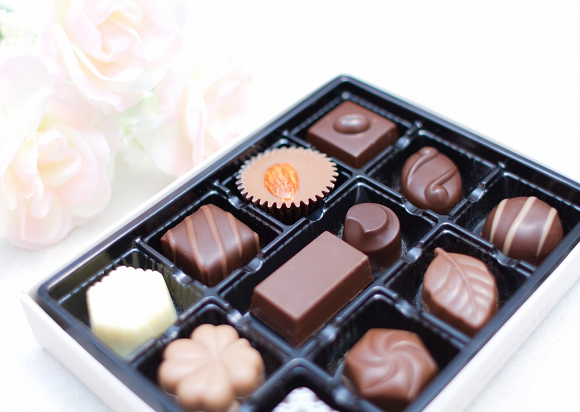
Despite the oppressive-sounding name, many see an upside to the practice.
Valentine’s Day in Japan is as much about the chocolate as it is about romance. But just as there are all sorts of romantic feelings, from a simple crush to a love that you feel from the bottom of your heart, so too are there many different classes of Valentine’s day chocolate in Japan.
In terms of volume, most of the chocolate purchased and given for Valentine’s Day is what’s known as giri choco, literally “obligation chocolate.” Giri choco doesn’t carry any significance of romantic love, but is instead given by women to their male coworkers and colleagues as a social nicety.
▼ Delicious duty
The Japanese division of multinational corporation 3M recently polled Japanese women about their giri choco plans, finding that out of 450 respondents, 39.8 percent planned on giving giri choco to a coworker this February. When asked why, the majority, 59.2 percent, said they’d be doing so to show their thanks for the general help and support they’d received from male coworkers throughout the year.
44.7 percent of also said they felt giri choco helped promote smoother workplace communication, and 18.4 also cited a simple desire to make the recipient happy as a reason. And down at number four on the list, 7.8 percent said they’d be giving giri choco this year simply because their female officemates were, and they felt going doing likewise was the least awkward option.
Regardless of the impetus, the average giri choco gift isn’t terribly expensive. 59.2 percent of the giri choco-giving respondents said they’ll be spending less than 500 yen (US$4.30) per person they plan to give some to, with another 34.1 percent budgeting between 501 to 1,000 yen per gift.
Also, while giri choco is commonly given at the office, women aren’t necessarily expected to give some to every male employee of the company, Often the gift-giving range is limited to teammates or people in the same division, and 68.2 percent of the gift-giving respondents will be buying giri choco for only one to five people, and only 12.8 percent will be handing out sweets to more than 10 guys.
Sifting through all those numbers means that many women are likely to be spending 2,500 yen or less for their giri choco activities, which isn’t a huge outlay. Still, hopefully their male coworkers will remember to return the favor one month later when White Day rolls around.
Source: PR Times
Top image: Pakutaso
Insert image: Pakutaso
[ Read in Japanese ]
Follow Casey on Twitter, where he’s happy to receive any delicious-looking photos of giri choco you care to send him, and will respond in kind for White Day.
[ Read in Japanese ]


 Only one demographic in survey is happy about Japan’s workplace obligation Valentine’s chocolate
Only one demographic in survey is happy about Japan’s workplace obligation Valentine’s chocolate Survey shows Japanese women would love to be getting some chocolate on Valentine’s Day too
Survey shows Japanese women would love to be getting some chocolate on Valentine’s Day too This Valentine’s Day, tell him you don’t love him with Japanese women’s “chocolate maggot” recipe
This Valentine’s Day, tell him you don’t love him with Japanese women’s “chocolate maggot” recipe Tokyo opens entire store dedicated to helping women buy obligation chocolate for Valentine’s
Tokyo opens entire store dedicated to helping women buy obligation chocolate for Valentine’s Godiva runs full-page ad asking Japanese women to stop buying so much Valentine’s chocolate
Godiva runs full-page ad asking Japanese women to stop buying so much Valentine’s chocolate Japan’s new difficult-to-drink-from beer glass protects your liver, but it’s a brutal experience
Japan’s new difficult-to-drink-from beer glass protects your liver, but it’s a brutal experience How to order snacks on a Shinkansen bullet train in Japan
How to order snacks on a Shinkansen bullet train in Japan Demon Slayer: Kimetsu no Yaiba gets new roller coaster attractions and food at Universal Studios Japan
Demon Slayer: Kimetsu no Yaiba gets new roller coaster attractions and food at Universal Studios Japan New Pokémon ice cream, dessert drinks, and cool merch coming to Baskin-Robbins Japan【Pics】
New Pokémon ice cream, dessert drinks, and cool merch coming to Baskin-Robbins Japan【Pics】 Burger King Japan suddenly adds Dr. Pepper and Dr. Pepper floats to its menu nationwide
Burger King Japan suddenly adds Dr. Pepper and Dr. Pepper floats to its menu nationwide Hello, cosmetics! Clinique teams up with Hello Kitty this summer for first-time collaboration
Hello, cosmetics! Clinique teams up with Hello Kitty this summer for first-time collaboration “The most Delicious Cup Noodle in history” – Japan’s French Cup Noodle wins our heart【Taste test】
“The most Delicious Cup Noodle in history” – Japan’s French Cup Noodle wins our heart【Taste test】 To combat declining birth rate, Japan to begin offering “Breeding Visas” to foreigners
To combat declining birth rate, Japan to begin offering “Breeding Visas” to foreigners Starbucks teams up with Japanese shochu brewery for a whole new coffee experience
Starbucks teams up with Japanese shochu brewery for a whole new coffee experience Studio Ghibli releases giant Totoro plushies in Japan
Studio Ghibli releases giant Totoro plushies in Japan Nintendo history you can feel – Super NES, N64, and GameCube controllers become capsule toys
Nintendo history you can feel – Super NES, N64, and GameCube controllers become capsule toys Starbucks releases a cute Frappuccino and Unicorn Cake…but not in Japan
Starbucks releases a cute Frappuccino and Unicorn Cake…but not in Japan Kyoto Tower mascot termination reveals dark side behind cute Japanese characters
Kyoto Tower mascot termination reveals dark side behind cute Japanese characters McDonald’s Japan’s Soft Twist Tower: A phantom ice cream only sold at select branches
McDonald’s Japan’s Soft Twist Tower: A phantom ice cream only sold at select branches Yabai Ramen: What makes this Japanese ramen so dangerous?
Yabai Ramen: What makes this Japanese ramen so dangerous? Finally! Nintendo Japan expands Switch 8-bit controller sales to everybody, Online member or not
Finally! Nintendo Japan expands Switch 8-bit controller sales to everybody, Online member or not Japanese government wants to build luxury resorts in all national parks for foreign tourists
Japanese government wants to build luxury resorts in all national parks for foreign tourists 10 things you should buy at 7-Eleven in Japan
10 things you should buy at 7-Eleven in Japan Studio Ghibli releases anime heroine cosplay dresses that are super comfy to wear
Studio Ghibli releases anime heroine cosplay dresses that are super comfy to wear Woman charged for driving suitcase without a license in Osaka
Woman charged for driving suitcase without a license in Osaka Studio Ghibli unveils My Neighbour Totoro miniature house model
Studio Ghibli unveils My Neighbour Totoro miniature house model Kyoto experiencing problems with foreign tourists not paying for bus fares, but not on purpose
Kyoto experiencing problems with foreign tourists not paying for bus fares, but not on purpose Fighting mild hunger with a Japanese soda that turns into jelly in the stomach【Taste test】
Fighting mild hunger with a Japanese soda that turns into jelly in the stomach【Taste test】 Studio Ghibli’s Howl’s Moving Castle tapestry unveiled in Japan for first time
Studio Ghibli’s Howl’s Moving Castle tapestry unveiled in Japan for first time McDonald’s new Happy Meals offer up cute and practical Sanrio lifestyle goods
McDonald’s new Happy Meals offer up cute and practical Sanrio lifestyle goods Sales of Japan’s most convenient train ticket/shopping payment cards suspended indefinitely
Sales of Japan’s most convenient train ticket/shopping payment cards suspended indefinitely Sold-out Studio Ghibli desktop humidifiers are back so Totoro can help you through the dry season
Sold-out Studio Ghibli desktop humidifiers are back so Totoro can help you through the dry season Japanese government to make first change to romanization spelling rules since the 1950s
Japanese government to make first change to romanization spelling rules since the 1950s Foreigner’s request for help in Tokyo makes us sad for the state of society
Foreigner’s request for help in Tokyo makes us sad for the state of society Ghibli founders Toshio Suzuki and Hayao Miyazaki contribute to Japanese whisky Totoro label design
Ghibli founders Toshio Suzuki and Hayao Miyazaki contribute to Japanese whisky Totoro label design Doraemon found buried at sea as scene from 1993 anime becomes real life【Photos】
Doraemon found buried at sea as scene from 1993 anime becomes real life【Photos】 Tokyo’s most famous Starbucks is closed
Tokyo’s most famous Starbucks is closed Princesses, fruits, and blacksmiths: Study reveals the 30 most unusual family names in Japan
Princesses, fruits, and blacksmiths: Study reveals the 30 most unusual family names in Japan Giri obligation chocolates seen as power harassment, more Japanese companies ban practice
Giri obligation chocolates seen as power harassment, more Japanese companies ban practice In Japan, women give “obligation chocolate” on Valentine’s Day, but do guys even want it?
In Japan, women give “obligation chocolate” on Valentine’s Day, but do guys even want it? Survey reveals Japanese men really want home-made chocolate, but are women willing to make it?
Survey reveals Japanese men really want home-made chocolate, but are women willing to make it? Is the coronavirus going to kill Japan’s obligation chocolate Valentine’s Day custom?
Is the coronavirus going to kill Japan’s obligation chocolate Valentine’s Day custom? Shabani the gorilla is so handsome he’ll be appearing on sweets in Japan this Valentine’s Day
Shabani the gorilla is so handsome he’ll be appearing on sweets in Japan this Valentine’s Day Japanese girls reveal who they really give most Valentine’s chocolates to, and it’s not boys
Japanese girls reveal who they really give most Valentine’s chocolates to, and it’s not boys JR East putting on love-handles for Valentine’s Day
JR East putting on love-handles for Valentine’s Day Barely half of Japanese men in survey will give thank-you gift to women for Valentine’s chocolate
Barely half of Japanese men in survey will give thank-you gift to women for Valentine’s chocolate Japanese chocolates come to life as ikemen “hot guy” anime characters
Japanese chocolates come to life as ikemen “hot guy” anime characters Chocolate-fed sushi fish set to become a Valentine’s Day treat in Japan
Chocolate-fed sushi fish set to become a Valentine’s Day treat in Japan Don’t bother, ladies: Survey reveals most Japanese guys don’t want your Valentine’s chocolate
Don’t bother, ladies: Survey reveals most Japanese guys don’t want your Valentine’s chocolate Family Mart holds its first-ever Mint Chocolate Fair with 9 intriguing types of snacks
Family Mart holds its first-ever Mint Chocolate Fair with 9 intriguing types of snacks Pokémon Valentine’s Day chocolates from Japan are just the thing for lovers who love Pokémon
Pokémon Valentine’s Day chocolates from Japan are just the thing for lovers who love Pokémon VR visit to Japanese swimsuit model’s apartment provides joy for dateless men on Valentine’s Day
VR visit to Japanese swimsuit model’s apartment provides joy for dateless men on Valentine’s Day Why you probably won’t get home-made Valentine chocolate and love confession from a Japanese girl
Why you probably won’t get home-made Valentine chocolate and love confession from a Japanese girl
Leave a Reply